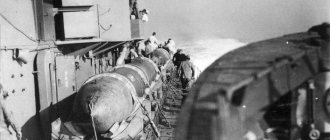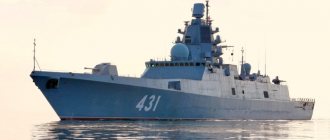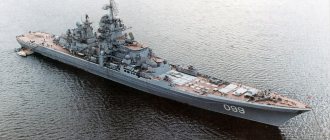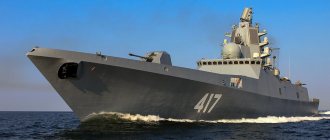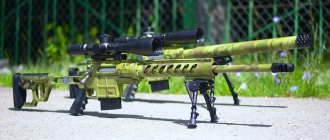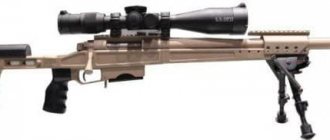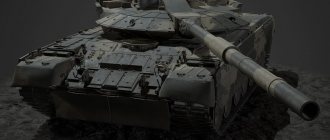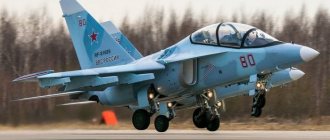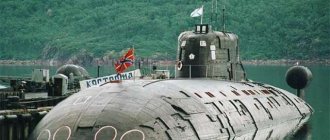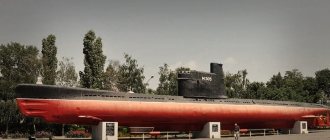For the term "Torpedo" see also other meanings.
Launching a torpedo from a Virginia-class submarine (artist's drawing) Torpedo compartment on the French nuclear submarine Le Redoutable Soviet torpedo from the Second World War, Malaya Zemlya Museum-Reserve, Novorossiysk
Torpedo
(from lat. torpedo narke - electric rays, abbreviated lat. torpedo) - a self-propelled underwater combat projectile. A naval torpedo consists of a cylindrical streamlined body with tail and propellers, or with a jet nozzle in the tail (torpedo missile). The warhead of a torpedo contains a nuclear or non-nuclear warhead, fuel, engine and control devices (including targeting). The engine used was initially piston internal combustion engines, later Walter engines and electric motors; The most powerful modern torpedoes can be nuclear-powered.
The most common caliber of naval torpedoes (hull diameter at its widest part) is 533 millimeters (21 inches) (samples from 254 to 660 mm are also known). The average length (for universal torpedoes) is about 7 meters, weight (for universal torpedoes) is about 2 tons, the explosive charge (for universal torpedoes) is 200-400 kilograms.
Naval torpedoes are in service with surface (torpedo boats, destroyers and others) and submarine ships, airplanes and helicopters, and as an integral part of anti-submarine missile systems.
The development of the torpedo required the solution of a number of complex technical problems through the efforts of several generations of inventors. Nevertheless, the latest problems in the development of torpedoes are still awaiting their constructive and scientific solution [1].
Origin of the term[ | ]
In the Russian language, the word “torpedo” was found already in 1864 [2], even before the invention of I. F. Aleksandrovsky. But then it did not mean a self-propelled device, but a sea mine (in the original - “an underwater vehicle used to blow up ships”).
In 1865 (a year before Whitehead patented the torpedo), I. F. Aleksandrovsky used the term “self-propelled torpedo” regarding his invention [3]. Later, this term did not catch on, and until 1917 and the reform of the army, torpedoes in the Russian fleet were called “self-propelled mines” or “Whitehead mines”, torpedomen were called “miners”, a torpedo attack was called a “mine attack”, and torpedo ships, respectively - “mine” (“destroyers”, “destroyers”, “destroyers”, etc.).
In the Russified form of “torpedoes ”
"The term has been used in print since at least 1877[4][5][2].
There is no consensus regarding the first use of this term in English. Some authoritative sources[6][7] claim that the first recording of this term dates back to 1776 and it was introduced into circulation by David Bushnell, the inventor of one of the first prototype submarines, the Turtle. According to another, more widespread version[2], the primacy of the use of this word in the English language belongs to Robert Fulton and dates back to the beginning of the 19th century (no later than 1810[8])
In both cases, the term “torpedo” did not mean a self-propelled cigar-shaped projectile, but an egg-shaped or barrel-shaped underwater contact mine [9], which had little in common with the Whitehead and Aleksandrovsky torpedoes.
Originally in English, the word “torpedo” refers to electric stingrays, and has existed since the 16th century and was borrowed from the Latin language (lat. torpedo), which, in turn, originally meant “numbness,” “rigidity,” “immobility.” The term is associated with the effect of the “impact” of an electric ramp[6].
The Navy will receive torpedoes and new generation nuclear submarines
The official statement also emphasizes that “by the end of 2017, it is planned to complete developments on the creation of a torpedo of the “Physicist” type, to produce small-sized anti-submarine torpedoes, as well as a hydroacoustic suppression device for the “Beryllium” code based on a torpedo carrier.”
In three years, in the Gelendzhik area on the Black Sea, on the basis of one of the research institutes, it is planned to create a year-round multi-purpose deep-sea testing ground for naval weapons. To conduct complex full-scale tests in conditions as close as possible to operational ones, we need a year-round deep-sea testing ground for testing all types of naval weapons. This is also important for guaranteeing the tactical and technical characteristics of the types of naval underwater weapons being adopted.
In addition, such a training ground makes it possible to demonstrate weapons and military equipment to customers, including foreign ones. This increases the competitiveness of Russian naval weapons on the world market. Currently in Russia there is no deep-sea specialized sea range operating year-round, and the production of fourth-generation torpedoes of the Fizik and Kant-3M types and the development of fifth-generation missiles of the Lomonos type within the framework of the state program require appropriate testing.
Let us recall that before the collapse of the Soviet Union, the main tests of naval underwater weapons were carried out at training grounds located in the Crimean Feodosia and in Kyrgyzstan on Lake Issyk-Kul.
A representative of the military-industrial complex clarified to the Rossiyskaya Gazeta correspondent that “in order to implement the state armament program for the period until 2022, related to the production of naval underwater weapons necessary for equipping ships and submarines, a plan for the creation of a sea training ground will be sent to the government for consideration in the near future for full-scale and state testing of all types of naval weapons.”
There are already underwater submarines for the torpedoes being developed.
The lead multi-purpose nuclear submarine (MPLATRK) of the 4th generation "Severodvinsk" pr. 885 of the "Yasen" type, armed with cruise missiles, has begun a state testing program at sea. At the same time, the planned shooting of the boat’s torpedo tubes did not take place. To arm the new nuclear submarine, 3 Kalibr cruise missiles have already been manufactured in a version with a firing range of 2,500 km.
The supersonic version of this missile with a conventional or nuclear warhead, on the way to a coastal or surface target, changes its flight path in course and altitude, while the flight speed of the missile warhead after its separation increases even more and approaches hypersonic.
Dossier "RG"
Kalibr cruise missiles are high-precision, ultra-high-speed weapons that are intended, for the most part, to combat enemy aircraft carriers. In accordance with the contract signed by USC and the Russian Ministry of Defense within the framework of the State Armament Program until 2020, the Russian fleet should receive 7 Yasen-class MPLATRKs, while 6 of the submarines will be built according to the improved 885M project. The lead modernized boat of the series is the Kazan. At the same time, this boat will become the first 4th generation nuclear submarine to receive completely new technical equipment, which has no analogues in the domestic shipbuilding industry.
Unlike the 4th generation strategic missile carriers of the Borei project - the nuclear submarines Yuri Dolgoruky and Alexander Nevsky, in which the technical filling used for the first time on them is about 40%, the multi-purpose nuclear submarine Kazan of the 885M project has all the components and systems and the mechanisms will be completely new, never used before. According to representatives of the defense industry, this is completely new, high-tech equipment that has no analogues in Soviet and modern Russian shipbuilding. In terms of its performance characteristics, the Kazan nuclear submarine should be comparable to the most high-tech and at the same time expensive submarine in the world - the American Seawolf-class multi-purpose nuclear submarine, while in terms of noise level and a number of other criteria it will even outperform its competitor.
The total cost of 7 Project 885 Yasen submarines exceeds 200 billion rubles. According to ITAR-TASS sources, one Project 885M nuclear submarine costs 1.5-2 times more than Project 955 Borei submarines.
The USSR began work on the creation of 4th generation submarines simultaneously with the United States back in 1977. Initially, it was planned to create several types of boats: multi-purpose, anti-aircraft, anti-submarine. But later it was decided to limit ourselves to only a multi-purpose submarine, which would be capable of solving the widest possible range of tasks. The design of the submarine was carried out by the Malachite Design Bureau, which had extensive experience in creating successful multi-purpose submarines. The new Project 885 nuclear submarine received the code "Ash", according to NATO codification - "Granay". The laying of the lead ship of the Severodvinsk series took place on December 21, 1993 at Sevmash in the city of Severodvinsk. The speed of building the boat was very slow due to very poor funding. On September 12, 2011, the lead boat K-329 “Severodvinsk” went to sea for the first time to conduct sea trials.
The main characteristics of the Project 885 nuclear submarine: maximum length - 120 meters, width - 15 meters, draft - 10 meters. Total displacement - 11,800 tons. The highest underwater speed is 31 knots. The boat's crew is 90 people (32 officers). The boat is equipped with a pop-up rescue chamber that can accommodate the entire crew.
Project 885 submarines are designed using a single-shaft design. The durable hull of the boats is made of steel. The nuclear power plant of these submarines belongs to the 4th generation reactors. The reactor power is 200 MW. The reactor is made according to an integrated layout diagram. The advantage of this solution is the localization of the primary coolant in a separate monoblock housing, as well as the absence of large diameter pipelines and pipes. This scheme involves the use of equipment that has very high reliability.
According to some experts, the new reactors can serve for quite a long time without recharging. The service life of the new reactors is estimated at 25-30 years, that is, comparable to the lifespan of the submarine itself.
The Yasen-type MPLATRKs have a one-and-a-half-hull design with a light hull only in the bow of the boat, as well as with a superstructure in the area of the missile silos. The submarine's durable steel hull is divided into 9 compartments. In the first compartment there is a central post with access to a durable wheelhouse - a pop-up rescue chamber, hardware equipment for the hydroacoustic complex and combat posts. Around the first compartment of the boat and forward of it there is a bow group of main ballast tanks (CBT, 5 in total). The second compartment contains the breech parts of the torpedo tubes, as well as racks with ammunition. The drives for retractable devices and some other auxiliary equipment of the boat are also located here. In the third compartment of the boat, on 4 decks, there is general ship and various instrumentation equipment, such as diesel generators, pumps and converters, and refrigeration machines. The fourth compartment is allocated for residential and medical premises, as well as some auxiliary systems.
Compartments 2 to 4 inclusive make up about 40% of the entire length of the submarine's durable hull and do not have a light hull, but only a light superstructure. Behind these compartments, the robust body receives a significant narrowing and a double-hull design.
The fifth compartment of the nuclear submarine is the missile compartment. In the area of this compartment there is a rapid immersion tank and a middle group of the Central City Hospital (4 tanks). The sixth compartment of the boat is the reactor compartment; around it there is a special surge tank, which is necessary to keep the boat in depth during missile firing.
The seventh (turbine) compartment contains steam turbine equipment, autonomous turbogenerators, and other power equipment. Around this compartment there is a stern group of the Central City Hospital (5 pieces in total).
The eighth compartment of the submarine is used to accommodate mechanical, general ship equipment; it also contains the aft hatch, behind which there is a tiller compartment with hydraulic drives for the stern empennage of the boat.
The entire bow of the Yasen-class nuclear submarine is dedicated to the placement of a large-sized spherical antenna of the hydroacoustic complex. Behind the radome of this antenna above the structural waterline are the bow horizontal rudders of the boat. The tail of the submarine is made according to the classic cruciform pattern. The submarine received a fairly long fencing of retractable devices in a “limousine” shape with an integrated pop-up rescue chamber.
The submarine's robust hull is made of low-magnetic steel (up to 48 mm thick). The boat hull is assembled using the block method using metal cable dampers, which are used instead of traditional rubber-cord pneumatic dampers. The ship's equipment is mounted in zonal blocks on special massive frames.
A new version of the layout of the power plant units, as well as cooling systems, power supply, and auxiliary equipment made it possible to reduce the noise level of the boat by 10-15 dB.
The design of the boat uses vibration-absorbing layered beams, elements of air ducts and pipelines, and pillars, which reduce noise by 10-30 dB. All equipment is mounted on vibration-absorbing honeycomb frames made of composite materials. Moreover, each structural block is additionally covered with soundproofing panels. The hull of the nuclear submarine itself is covered with a rubber anti-hydroacoustic coating, which reduces the noise of the boat and also reduces the reflection of sonar signals. Yasen also uses an active noise suppression system in the limit of discrete components with a frequency of 50-500 Hz. To reduce the noise of the boat at low speeds, only a propeller electric motor is used, while at the same time the main turbo-gear unit is connected through a coupling only at high-speed operating modes.
The Project 885 submarine is made according to a single-shaft design and is equipped with a 7-bladed low-noise propeller with saber-shaped blades (with composite damping). The screw has a fixed pitch. The boat also has 4 folding thrusters and bow horizontal rudders with flaps, most likely retractable.
The main weapons of the nuclear submarine are vertical launch cruise missiles. The submarine has 8 SM-346 launchers (4 per side) for 24 P-800 Oniks anti-ship missiles. It is also possible to use 3M14 missiles
"Caliber" and 3M54 "Turquoise". To interface various missile systems on board the submarine, a universal shipborne fire control system 3R-14P was created, which ensures the combat readiness of the submarine's missile system for launch from a cold state of the equipment within 4 minutes. Along with this, the ground-based equipment complex, which is intended for routine maintenance of missiles, was also unified.
In addition to cruise missiles, the boat is armed with various torpedoes.
"Yasen" has 10 torpedo tubes (5 per side) of 533 mm caliber. Ammunition of torpedoes - 30 pieces: USET-80, "Physicist-1" (UGST), etc., as well as the RK-55 CRBD "Granat" or "Biryuza" or the Vodopad anti-aircraft missile system, as well as mines.
The boat's torpedo tubes are located in the central part of the hull behind the central post. On the submarine it is possible to install 533-mm disposable non-rechargeable PU hydroacoustic countermeasures of the REPS-324 “Barrier” type for the use of self-propelled hydroacoustic countermeasures MG-114 “Beryl” and MG-104 “Throw”.
Project 885 nuclear submarines are equipped with the Okrug combat information and control system, which combines real-time monitoring of information about the state of the ship, all combat systems, information from surveillance and target designation equipment. The operation of the BIUS is ensured using several on-board computers. The Okrug can transmit and receive information from other ships using a secure underwater data transmission system.
Classification[ | ]
Modern torpedoes are classified according to the following defining characteristics: By purpose
- Anti-ship (initially all torpedoes);
- Anti-submarine (intended to destroy submarines).
- Universal (designed to destroy both surface and submarine ships);
Engine of a steam-gas torpedo. Submarine S-56, Vladivostok. By carrier
- For surface ships;
- Unified for submarines and surface ships;
- Unified for helicopters and anti-submarine aircraft;
- Used as warheads in missile torpedoes;
- Used as combat units in torpedo mines[10];
By type of engine (by type of power plant)
- On compressed air (before the First World War);
- Steam-gas - liquid fuel burns in compressed air (oxygen) with the addition of water, and the resulting mixture rotates a turbine or drives a piston engine; A separate type of steam-gas torpedoes are torpedoes from the Walther gas turbine unit.
- Powder - gases from slowly burning gunpowder rotate the engine shaft or turbine;
- Electrical;
- Jet - do not have propellers, they use jet propulsion (torpedoes: RAT-52, Shkval). It is necessary to distinguish rocket torpedoes from rocket torpedoes, which are missiles with warheads-stages in the form of torpedoes (missile torpedoes “ASROC”, “Waterfall”, etc.).
By pointing method
- Uncontrolled - the first samples;
- Upright - with a magnetic compass or gyroscopic semi-compass;
- Maneuvering according to a given program (circulating) in the area of the intended targets - used by Germany in the Second World War;
- Homing passive - by physical target fields, mainly by noise or changes in the properties of water in the wake (first used in World War II), acoustic torpedoes Zaukenig (Germany, used by submarines) and Mark 24 FIDO (USA, used only from aircraft , since they could hit their ship);
- Homing active - have a sonar on board. Many modern anti-submarine and multi-purpose torpedoes;
- Remote-controlled - targeting is carried out from a surface or underwater ship via wires (fiber optics).
Firing a Mk.46 anti-submarine torpedo from the destroyer URO Preble (USA) By type of charge used
- With a charge of ordinary explosive;
- With nuclear weapons[10];
By the method of detonating the charge (by type of fuse)
- With contact fuse;
- With non-contact fuse;
- With a combined fuse;
- With a remote fuse[10].
By size
- Small-sized (caliber up to 400 mm);
- Medium-sized (caliber up to 550 mm);
- Large-sized (caliber more than 600 mm)[10].
By travel modes
- Single-mode;
- Multi-mode (with mode switching on the go and during cooking)[10];
By trajectory type
- Upright;
- Maneuvering[10];
By trace
- Followers;
- Without a Trace[10];
The first Soviet nuclear boats of Project 627 were supposed to be armed with the largest T-15 torpedoes, 1550 mm caliber, which were supposed to deliver super-powerful thermonuclear charges (100 Mt) to enemy naval bases. However, the project was closed and the boats received conventional 533 mm torpedoes (including those with a nuclear warhead).
“Case” for sea power: new Russian torpedo
From their very first appearance in the theater of operations, submarines demonstrated their most formidable weapons: self-propelled mines or, as we know them better, torpedoes. Now new submarines are entering service with the Russian fleet, and they need new modern weapons. And it is already ready: the newest deep-sea torpedoes “Case”.
In the last article with infographics, we talked about the new Russian ballistic missile submarine (ballistic missile submarine) of the Borei project. This is the latest ship, equipped with a number of innovations, both in design and equipment, and in weapons.
First of all, this is, of course, the R-30 Bulava ballistic missile. It is for this rocket that the Borei project was created. However, the submarine missile carrier also has the traditional submarine weapon with which this type of warship was born: torpedo tubes.
A little history
It must be said that Russia was one of the founders of a new type of underwater weapon. This applies to sea mines, torpedoes, and submarines themselves. The world's first successful mining was carried out by us during the Crimean War. Then, in 1854, the approaches to Kronstadt and part of the mouth of the Neva were mined. As a result, several English frigate steamers were damaged, and the Allied attempt to attack St. Petersburg failed.
Giovanni da Fontana at the beginning of the 15th century . In principle, this idea was then implemented in the form of so-called “fire ships” - sailing ships filled with gunpowder and flammable materials, which were sent under sail to the enemy squadron.
Later, when the sail began to be replaced by the steam engine, the term torpedo to designate naval ammunition was used at the beginning of the 19th century by the creator of one of the first steamships and the submarine project, Robert Fulton .
However, the first workable working model of a torpedo was created by a Russian engineer and inventor, artist and photographer Ivan Fedorovich Aleksandrovsky . By the way, in addition to the torpedo and submarine with compressed air engines (a principle that became one of the main ones in mining over the next 50 years), which Ivan Fedorovich created in 1865 and 1866 at the Baltic Shipyard, the Russian engineer was known for a number of inventions in photography . Including the principle of stereoscopic shooting.
The following year, 1868, the English engineer Robert Whitehead created the first industrial prototype of a torpedo, which began to be mass-produced and entered service with many navies around the world under the name “Whitehead torpedoes.”
However, the British themselves were not initially very lucky with the torpedo. The first time the English fleet used a torpedo was in the Battle of Pacocha Bay, when two English ships - the wooden corvette Amethyst and the flagship frigate Shah - attacked the Peruvian armored monitor Huascar. The Peruvian sailors did not have much experience in maritime affairs, but easily dodged the torpedo.
And again the palm went to Russia. On January 14, 1878, as a result of an operation carried out under the leadership of Admiral Stepan Osipovich Makarov against the Turkish fleet in the Batum area, two boats, Chesma and Sinop, launched from the mine transport Grand Duke Konstantin, sank the Turkish steamer Intibakh. This was the world's first successful attack using torpedoes.
From that moment on, torpedoes began their triumphal march in naval theaters of combat. The firing range reached tens of kilometers, the speed exceeded the speed of the fastest submarines and surface ships, with the exception of ekranoplanes (but this is more of a low-flying aircraft than a ship). From unguided torpedoes, they first became stabilized (floating according to a program, using gyrocompasses), and then both controllable and homing.
They were no longer placed only on submarines and surface ships, but also on aircraft, missiles and coastal installations. Torpedoes had a wide variety of calibers, from 254 to 660 mm (the most common caliber was 533 mm) and carried up to half a ton of explosives.
It is noteworthy that the most powerful torpedo in the world was developed in the USSR. The first Soviet nuclear boats of Project 627 were supposed to be armed with truly gigantic T-15 torpedoes, 1550 (!) mm caliber with a nuclear warhead.
By the way, the idea of these torpedoes was proposed by the famous fighter for peace and against totalitarianism, Academician Andrei Dmitrievich Sakharov . According to his humanistic thought, T-15 torpedoes were supposed to deliver super-powerful thermonuclear charges (100 megatons) to enemy naval bases to cause a tsunami there that would sweep away the entire coastal strip and could potentially destroy cities such as San Francisco or most of Atlanta.
Amazingly, having familiarized themselves with the calculations of the destruction that these torpedoes could cause, the admirals of the Soviet fleet rejected this idea outright as inhumane. According to legend, the commander of the USSR fleet, Fleet Admiral Sergei Georgievich Gorshkov, said then that he was “a sailor, not an executioner.”
And yet torpedoes, despite their advanced age, remain in service as a type of military equipment.
Why are torpedoes needed?
If submarines need missiles to hit targets, mainly on the shore, then for naval duels they cannot do without torpedoes and missile-torpedoes (a multi-stage missile that is launched along an air trajectory, and hits the target with its head stage already under water in torpedo mode ).
New boats need new weapons, and the Russian Navy is currently testing the new Futlyar torpedo. This is a long-range deep-sea torpedo. It moves at a depth of almost half a kilometer at a speed of about a hundred kilometers per hour and is capable of reaching a target at a distance of up to 50 kilometers. The target can also be surface - the torpedo is universal. But the main target is the enemy's hunter boats - the main enemies of missile submarines.
The new torpedo is designed to replace the universal deep-sea homing torpedo (UGST) of the Physicist project. In essence, “Case” is a further improvement of the “Physicist” project. The characteristics of both torpedoes are, in principle, close in numerical terms. However, there are also significant differences.
The development of the previous version of the universal deep-sea homing torpedo - “Physics” - began in the USSR in 1986. The torpedo was designed in St. Petersburg, at the Morteplotekhnika Research Institute. The Physicist was put into service in 2002, that is, 16 years later.
With the new “Case” torpedo, everything happens much faster. It is now undergoing state tests, and if positive results are obtained, it will enter service this year in 2016. Moreover, its serial production will begin next year – 2017. The speed of development for this type of weapon is enviable.
The boats of Project 955 SSBN “Borey” and Project 885 SSGN (with cruise missiles) “Yasen” will be equipped with “Cases”. “Borey” has six bow 533-mm torpedo tubes, and “Yasen” has ten of the same tubes, but located vertically in the middle part of the hull.
Enemy Weapons
What do our sworn “friends” have? In US arsenal, the main long-range deep-sea torpedo is the Gould Mark 48 torpedo. It has been in service since the late 70s. The American torpedo has a greater launch depth - about 800 meters - and surpasses both the Physics and the Case in this indicator.
True, this characteristic sounds more conventional than it has any significance in practice, since the maximum diving depth of the American Ohio series boat is 550 meters, and its potential target - the deepest of the Russian submarines Yasen - has a maximum permissible diving depth of 600 meters. So, at a depth of 800 meters, the Mark 48 torpedo can only hunt sperm whales.
But in another characteristic, much more important - range, the Mark 48 is significantly inferior to the Case. At a maximum speed of 55 knots (here “Futlyar” and Mark 48 are almost equal), the range of the American torpedo does not exceed 38 kilometers versus 50 for “Futlyar”. In order to fire a shot at the maximum distance of 50 km, the torpedo is forced to switch to an economical speed of 40 knots. That is, reduce the speed by one and a half times.
But the main advantage of the “Case”, about which there are more rumors than real data due to the high secrecy of the project, is the complex for overcoming the anti-torpedo protection of enemy warships. The fact is that torpedoes can be dealt with in two ways: by jamming and launching so-called anti-torpedoes and decoy targets (often these are also special torpedoes), simulating the acoustic, hydrodynamic, magnetic and thermal underwater picture of a real moving warship. Apparently, “Case” will be able to bypass these levels of protection.
It is still unknown exactly what exactly this complex includes; these are probably passive means that help to rebuild guidance systems from interference, but apparently also means of electronic jamming. Perhaps the “Case” will not only not be confused by false targets, but will also be able to set such traps for enemy anti-torpedoes.
For now, we don’t know exactly what’s hidden in the new “Case.” But one thing can be said with confidence: there is nothing pleasant there for our potential enemy.
This is clearly not a birthday present for NATO.
Download original:
History[ | ]
| This section is not completed. You will help the project by correcting and expanding it. |
Robert Whitehead and his torpedo Dropping a torpedo from a British aircraft (circa 1918) Mine (torpedo) compartment of a submarine during the First World War.
1916 Mk.46 torpedoes on the suspensions of the Lynx anti-submarine helicopter The Italian engineer Giovanni da Fontana was the first to express the idea of a self-propelled naval projectile at the beginning of the century[11]. The term “torpedo” was first used to refer to naval ammunition by Robert Fulton at the beginning of the 19th century. Throughout the 19th century, various engineers developed projects for underwater self-propelled projectiles, but with rocket propulsion.
The first self-propelled mine (“self-propelled torpedo”) was created in 1865 by the Russian inventor I. F. Aleksandrovsky[3][12].
“In 1865,” writes Aleksandrovsky, “I presented... to Admiral N.K. Krabbe (manager of the Naval Ministry of Autonomous Republic) a project for a self-propelled torpedo that I had invented. The essence... the torpedo is nothing more than a miniature copy of the submarine I invented. As in my submarine, so in my torpedo, the main engine is compressed air, the same horizontal rudders for direction at the desired depth... with the only difference that the submarine is controlled by people, and the self-propelled torpedo... by an automatic mechanism. Upon presentation of my project for a self-propelled torpedo, N. K. Krabbe found it premature, because at that time my submarine was just being built.”
— [3]
The first samples of torpedoes (Whitehead torpedoes) were developed by the Englishman Robert Whitehead (1866). On May 29, 1877, during the Battle of Pacocha Bay, a torpedo was used for the first time by the British fleet in combat conditions, but without success - the target managed to evade the hit.
Torpedoes were first successfully used by Russia during the Russo-Turkish War of 1877-1878. On January 14, 1878, as a result of an operation carried out under the leadership of Admiral Makarov against the Turkish fleet in the Batum area, two boats, Chesma and Sinop, launched from the mine transport Grand Duke Konstantin, sank the Turkish steamer Intibah. Torpedoes were also actively used during the first Russo-Japanese War.
Apparently, the first guided torpedo was the Brennan Torpedo, developed in 1877.
First World War[ | ]
“The moment a mine leaves a gun” (1916)
During the First World War, torpedoes were used by the warring parties not only in the sea, but also on rivers: for example, on August 27, 1916, Romanian torpedo boats attacked Austro-Hungarian monitors near the Bulgarian city of Ruse on the Danube. The attack was unsuccessful for the Romanians: the torpedoes missed their targets, and the flagship of the Austrian group, Bodrog, sank one of the attacking boats.
World War II[ | ]
Electric torpedoes
One of the disadvantages of steam-gas torpedoes is the presence of a trace (exhaust gas bubbles) on the surface of the water, unmasking the torpedo and creating the opportunity for the attacked ship to evade it and determine the location of the attackers, therefore, after the First World War, attempts began to use an electric motor as a torpedo engine. The idea was obvious, but none of the states, except Germany, could implement it before the start of World War II. In addition to tactical advantages, it turned out that electric torpedoes are relatively simple to manufacture (for example, the labor costs for the manufacture of a standard German steam-gas torpedo G7a (T1) ranged from 3,740 man-hours in 1939 to 1,707 man-hours in 1943; and for production one G7e electric torpedo (T2) required 1255 man-hours). However, the maximum speed of the electric torpedo was only 30 knots, while the steam-gas torpedo reached a speed of up to 46 knots. There was also the problem of eliminating hydrogen leakage from the torpedo battery, which sometimes led to its accumulation and explosions.
In Germany, an electric torpedo was created back in 1918, but they did not have time to use it in combat. Development continued in 1923, in Sweden. In 1929, the new electric torpedo was ready for mass production, but it was officially put into service only in 1939 under the designation G7e. The work was so secret that the British only learned about it in 1939, when parts of such a torpedo were discovered during an inspection of the battleship Royal Oak, which was torpedoed in Scapa Flow in the Orkney Islands.
However, already in August 1941, fully serviceable 12 such torpedoes fell into the hands of the British on the captured U-570. Despite the fact that both Britain and the USA already had prototypes of electric torpedoes at that time, they simply copied the German one and adopted it for service (though only in 1945, after the end of the war) under the designation Mk-XI in British and Mk-18 in the US Navy.
Work on the creation of a special electric battery and electric motor intended for 533 mm torpedoes began in 1932 in the Soviet Union. During 1937-1938. two experimental electric torpedoes ET-45 with a 45 kW electric motor were manufactured. It showed unsatisfactory results, so in 1938 a fundamentally new electric motor was developed with an armature and a magnetic system rotating in different directions, with high efficiency and satisfactory power (80 kW). The first samples of the new electric torpedo were made in 1940. And although the German G7e electric torpedo fell into the hands of Soviet engineers, they did not copy it, and in 1942, after state tests, the domestic ET-80 torpedo was put into service . The first five ET-80 combat torpedoes arrived at the Northern Fleet in early 1943. In total, Soviet submariners used 16 electric torpedoes during the war.
Thus, in reality, in World War II, Germany and the Soviet Union had electric torpedoes in service. The share of electric torpedoes in the ammunition load of Kriegsmarine submarines was up to 80%.
Proximity fuses
Independently of each other, in strict secrecy and almost simultaneously, the navies of Germany, England and the United States developed magnetic fuses for torpedoes. These fuses had a great advantage over simpler contact fuses. Mine-resistant bulkheads located below the armored belt of the ships minimized the destruction caused when a torpedo hit the side. For maximum effectiveness of destruction, a torpedo with a contact fuse had to hit the unarmored part of the hull, which turned out to be a very difficult task. The magnetic fuses were designed in such a way that they were triggered by changes in the Earth's magnetic field under the steel hull of the ship and exploded the torpedo warhead at a distance of 0.3-3 meters from its bottom. It was believed that a torpedo explosion under the bottom of a ship caused two or three times more damage than an explosion of the same power at its side.
However, the first German magnetic fuses of the static type (TZ1), which responded to the absolute value of the strength of the vertical component of the magnetic field, simply had to be withdrawn from service in 1940, after the Norwegian operation. These fuses were triggered after the torpedo had passed a safe distance, even in light sea conditions, during circulation, or when the torpedo’s movement in depth was not stable enough. As a result, this fuse saved several British heavy cruisers from certain destruction.
New German proximity fuses appeared in combat torpedoes only in 1943. These were magnetodynamic fuses of the Pi-Dupl type, in which the sensitive element was an induction coil fixedly mounted in the fighting compartment of the torpedo. Pi-Dupl fuses responded to the rate of change in the vertical component of the magnetic field strength and to the change in its polarity under the ship’s hull. However, the response radius of such a fuse in 1940 was 2.5-3 m, and in 1943 on a demagnetized ship it barely reached 1 m.
Only in the second half of the war did the German fleet adopt the TZ2 proximity fuse, which had a narrow response band that lay outside the frequency ranges of the main types of interference. As a result, even against a demagnetized ship, it provided a response radius of up to 2-3 m at angles of contact with the target from 30 to 150°, and with a sufficient travel depth (about 7 m), the TZ2 fuse had practically no false alarms due to rough seas. The disadvantage of the TZ2 was its requirement to ensure a sufficiently high relative speed of the torpedo and the target, which was not always possible when firing low-speed electric homing torpedoes.
In the Soviet Union it was a fuse of the NBC type ( non-contact fuse with a stabilizer
;
This is a generator-type magnetodynamic fuse, which was triggered not by the magnitude, but by the speed of change in the vertical component of the magnetic field strength of a ship with a displacement of at least 3000 tons at a distance of up to 2 m from the bottom). It was installed on 53-38 torpedoes (NBC could only be used in torpedoes with special brass combat charging compartments). Maneuvering devices
During the Second World War, work continued on the creation of maneuvering devices for torpedoes in all leading naval powers. However, only Germany was able to bring prototypes to industrial production ( faT
and its improved version
LuT
).
FaT[ | ]
The first example of the FaT guidance system was installed on a TI (G7a) torpedo. The following control concept was implemented - the torpedo in the first section of the trajectory moved linearly over a distance from 500 to 12,500 m and turned in any direction at an angle of up to 135 degrees across the movement of the convoy, and in the zone of destruction of enemy ships, further movement was carried out along an S-shaped trajectory (“ snake") at a speed of 5-7 knots, while the length of the straight section ranged from 800 to 1600 m and the circulation diameter was 300 m. As a result, the search trajectory resembled the steps of a ladder. Ideally, the torpedo should have searched for a target at a constant speed across the direction of movement of the convoy. The probability of being hit by such a torpedo, fired from the forward heading angles of a convoy with a “snake” across its course of movement, turned out to be very high.
Since May 1943, the following modification of the FaTII guidance system (the length of the “snake” section is 800 m) began to be installed on TII (G7e) torpedoes. Due to the short range of the electric torpedo, this modification was considered primarily as a self-defense weapon, fired from the stern torpedo tube towards the pursuing escort ship.
LuT[ | ]
The LuT guidance system was developed to overcome the limitations of the FaT system and entered service in the spring of 1944. Compared to the previous system, the torpedoes were equipped with a second gyroscope, as a result of which it became possible to set turns twice before the start of the “snake” movement. Theoretically, this made it possible for the submarine commander to attack the convoy not from the bow heading angles, but from any position - first the torpedo overtook the convoy, then turned to its bow corners, and only after that began to move in a “snake” across the convoy’s course of movement. The length of the “snake” section could vary in any range up to 1600 m, while the speed of the torpedo was inversely proportional to the length of the section and was for G7a with the initial 30-knot mode set to 10 knots with a section length of 500 m and 5 knots with a section length of 1500 m .
The need to make changes to the design of the torpedo tubes and the computing device limited the number of boats prepared to use the LuT guidance system to only five dozen. Historians estimate that German submariners fired about 70 LuT torpedoes during the war.
Aviation torpedoes[ | ]
German aircraft torpedoes were frankly bad, they were worse than their Soviet counterparts. Hydrostats and non-contact electromagnetic fuses worked disgustingly, which forced the Italian “W” torpedo into service at the end of 1941. Later they began to produce a modernized version of the Italian - F5b, which differed from the original by another gyroscope, an additional Aubrey device and a cylindrical insert with additional rudders to improve entry into the water.
U-Boote.ru
TORPEDOES OF GERMAN SUBMARINES
The nomenclature of German torpedoes may seem extremely confusing at first glance, but there were only two main types of torpedoes on submarines, differing in different fuses and course control systems.
In fact, these two types G7a and G7e were modifications of the 500 mm G7 torpedo, which was used during the First World War. By the beginning of World War II, the caliber of torpedoes was standardized and adopted as 21 inches (533 mm). The standard length of the torpedo was 7.18 m, the explosive mass of the warhead was 280 kg. Due to the battery weighing 665 kg, the G7e torpedo was 75 kg heavier than the G7a (1603 and 1528 kg, respectively). The fuses used to detonate torpedoes were a source of great concern to submariners, and many failures were recorded early in the war. By the beginning of World War II, the G7a and G7e torpedoes were in service with a contact-non-contact fuse Pi1, triggered by a torpedo hitting the ship’s hull, or by exposure to a magnetic field created by the ship’s hull (modifications TI and TII, respectively). It soon became clear that torpedoes with proximity fuzes often went off prematurely or did not explode at all when passing under the target. Already at the end of 1939, changes were made to the design of the fuse that made it possible to disable the non-contact contactor circuit. However, this was not a solution to the problem: now, when hitting the side of a ship, torpedoes did not explode at all. After identifying the causes and eliminating the defects, since May 1940, the torpedo weapons of German submarines have reached a satisfactory level, except for the fact that a workable contact-proximity fuse Pi2, and even then only for G7e torpedoes of the TIII modification, entered service by the end of 1942 ( The Pi3 fuze developed for G7a torpedoes was used in limited quantities between August 1943 and August 1944 and was considered not reliable enough).
Torpedo tubes on submarines were usually located inside a pressure hull at the bow and stern. The exception was Type VIIA submarines, which had one torpedo tube installed in the aft superstructure. The ratio of the number of torpedo tubes to the displacement of the submarine, and the ratio of the number of bow and stern torpedo tubes remained standard. On the new submarines of the XXI and XXIII series, stern torpedo tubes were structurally absent, which ultimately led to some improvement in speed characteristics when moving under water.
The torpedo tubes of German submarines had a number of interesting design features. Changing the depth of travel and the angle of rotation of the torpedo gyroscope could be carried out directly in the devices, from the computing device (CSD) located in the conning tower. Another feature worth noting is the ability to store and deploy TMB and TMC proximity mines from the torpedo tube.
TYPES OF TORPEDOES
TI(G7a)
This torpedo was a relatively simple weapon that was propelled by steam generated by the combustion of alcohol in a stream of air coming from a small cylinder. The TI(G7a) torpedo had two propellers that rotated in antiphase. The G7a could be equipped with 44, 40 and 30-knot modes, in which it could travel 5500, 7500 and 12500 m, respectively (later, as torpedoes were improved, the range increased to 6000, 8000 and 12500 m). The main disadvantage of the torpedo was its bubble trail, and therefore it was more appropriate to use it at night.
TII(G7e)
The TII(G7e) model had much in common with the TI(G7a), but was driven by a small 100 hp electric motor that rotated two propellers. The TII(G7e) torpedo did not create a noticeable wake, developed a speed of 30 knots and had a range of up to 3000 m. The G7e production technology was developed so effectively that the production of electric torpedoes turned out to be simpler and cheaper compared to their steam-gas counterpart. As a result of this, the usual ammunition load of a Series VII submarine at the beginning of the war consisted of 10-12 G7e torpedoes and only 2-4 G7a torpedoes.
TIII(G7e)
The TIII(G7e) torpedo developed a speed of 30 knots and had a range of up to 5000 m. An improved version of the TIII(G7e) torpedo, adopted for service in 1943, received the designation TIIIa(G7e); This modification had an improved battery design and a torpedo heating system in the torpedo tube, which made it possible to increase the effective range to 7500 m. The FaT guidance system was installed on torpedoes of this modification.
TIV(G7es) "Falke" ("Hawk")
At the beginning of 1942, German designers managed to develop the first homing acoustic torpedo based on the G7e. This torpedo received the designation TIV(G7es) “Falke” (“Hawk”) and was put into service in July 1943, but was almost never used in combat (about 100 were manufactured). The torpedo had a proximity fuse, the explosive mass of its warhead was 274 kg, however, with a fairly long range - up to 7500 m - it had a reduced speed - only 20 knots. The peculiarities of the propagation of propeller noise under water required firing from the target's aft heading angles, but the probability of catching it with such a slow torpedo was low. As a result, TIV(G7es) was considered suitable only for firing at large vehicles moving at a speed of no more than 13 knots.
TV(G7es) "Zaunkonig" ("Wren")
A further development of the TIV(G7es) “Falke” (“Hawk”) was the development of the homing acoustic torpedo TV(G7es) “Zaunkonig” (“Wren”), which entered service in September 1943. This torpedo was intended primarily to combat escort ships of Allied convoys, although it could also be used successfully against transport ships. It was based on the G7e electric torpedo, but its maximum speed was reduced to 24.5 knots to reduce the torpedo's own noise. This had a positive effect - the range increased to 5750 m.
The TV(G7es) torpedo “Zaunkonig” (“Wren”) had the following significant drawback - it could mistake the boat itself for a target. Although the homing device was turned on after traveling 400 m, standard practice after launching a torpedo was to immediately dive the submarine to a depth of at least 60 m.
TXI(G7es) “Zaunkonig-II” (“Wren-II”)
To combat acoustic torpedoes, the Allies began to use a simple “Foxer” device, towed by an escort ship and creating noise, after which in April 1944 the homing acoustic torpedo TXI (G7es) “Zaunkonig-II” (“Wren-II”) was adopted for submarine service "). It was a modification of the TV(G7еs) “Zaunkonig” (“Wren”) torpedo and was equipped with an anti-jam homing device tuned to the characteristic frequencies of the ship’s propellers. However, the homing acoustic torpedoes did not bring the expected results: out of 640 TV(G7es) and TXI(G7es) torpedoes fired at the ships, according to various sources, 58 or 72 hits were noted.
COURSE GUIDANCE SYSTEMS
FaT - Flachenabsuchender Torpedo
Due to the growing complexity of combat conditions in the Atlantic in the second half of the war, it became increasingly difficult for “wolf packs” to break through the guards of convoys, as a result of which, in the fall of 1942, torpedo guidance systems underwent another modernization. Although German designers took care of introducing the FaT and LuT systems in advance, providing space for them in submarines, only a small number of submarines received FaT and LuT equipment in full.
The first example of the Flachenabsuchender Torpedo (horizontally maneuvering torpedo) guidance system was installed on the TI(G7a) torpedo. The following control concept was implemented - the torpedo in the first section of the trajectory moved linearly over a distance from 500 to 12,500 m and turned in any direction at an angle of up to 135 degrees across the movement of the convoy, and in the zone of destruction of enemy ships, further movement was carried out along an S-shaped trajectory (“ snake") at a speed of 5-7 knots, while the length of the straight section ranged from 800 to 1600 m and the circulation diameter was 300 m. As a result, the search trajectory resembled the steps of a ladder. Ideally, the torpedo should have searched for a target at a constant speed across the direction of movement of the convoy. The probability of being hit by such a torpedo, fired from the forward heading angles of a convoy with a “snake” across its course of movement, turned out to be very high.
Since May 1943, the next modification of the FaTII guidance system (the length of the “snake” section is 800 m) began to be installed on TII (G7e) torpedoes. Due to the short range of the electric torpedo, this modification was considered primarily as a self-defense weapon, fired from the stern torpedo tube towards the pursuing escort ship.
LuT - Lagenuabhangiger Torpedo
The Lagenuabhangiger Torpedo (self-guided torpedo) guidance system was developed to overcome the limitations of the FaT system and entered service in the spring of 1944. Compared to the previous system, the torpedoes were equipped with a second gyroscope, as a result of which it became possible to set turns twice before the start of the “snake” movement. Theoretically, this made it possible for the submarine commander to attack the convoy not from the bow heading angles, but from any position - first the torpedo overtook the convoy, then turned to its bow corners, and only after that began to move in a “snake” across the convoy’s course of movement. The length of the “snake” section could vary in any range up to 1600 m, while the speed of the torpedo was inversely proportional to the length of the section and was for G7a with the initial 30-knot mode set to 10 knots with a section length of 500 m and 5 knots with a section length of 1500 m .
The need to make changes to the design of torpedo tubes and the computing device limited the number of boats prepared to use the LuT guidance system to only five dozen. Historians estimate that German submariners fired about 70 LuT torpedoes during the war.
ACOUSTIC GUIDANCE SYSTEMS
"Zaunkonig" ("Wren")
This device, installed on G7e torpedoes, had acoustic target sensors, which ensured homing of torpedoes based on the cavitation noise of the propellers. However, the device had the disadvantage that it could operate prematurely when passing through a turbulent wake. In addition, the device was capable of detecting cavitation noise only at target speeds of 10 to 18 knots at a distance of about 300 m.
"Zaunkonig-II" ("Wren-II")
This device had acoustic target sensors tuned to the characteristic frequencies of the ship's propellers to eliminate the possibility of premature operation. Torpedoes equipped with this device were used with some success as a means of combating convoy guard ships; The torpedo was launched from the stern apparatus towards the pursuing enemy.
See also[ | ]
| Wiktionary has an entry for " torpedo " |
- Torpedo attack
- Rocket torpedo
- A sea mine (the original definition of a torpedo was a “self-propelled mine”) a towed mine - the first weapon of the first mine boats (a sea mine towed into an attack using a cable)
- pole mine - a mine attached to a pole in front of a mine boat and exploding when it hits an obstacle
- throwing mine
aircraft:
- Torpedo bomber
- Kettering aerial torpedo
ships:
- Submarine
- torpedo boat
- Destroyer
- Destroyer
other:
- Torpedo Data Computer is one of the earliest analog computers, used on American submarines of World War II to calculate the course of a torpedo.
- Bangalore torpedo
Notes[ | ]
- Torpedoes, 1986, p. 3.
- ↑ 123
P. I am Chernykh. Historical and etymological dictionary of the modern Russian language. 1994. Moscow. "Russian language". ISBN 5-200-02282-7 - ↑ 123
[wunderwaffe.narod.ru/WeaponBook/MO_01/chap02.html Yu. L. Korshunov, G. V. Uspensky. Torpedoes of the Russian fleet] - Anecdotal history of the current war: April, May, June and July 1877 (unspecified)
. - The term "torpedo" in Google Books (undefined)
. - ↑ 1 2
torpedo |
Search Online Etymology Dictionary (undefined)
.
www.etymonline.com
. Access date: January 16, 2022. - Bestiaria Latina: Audio Latin Proverbs: Ex labore dulcedo (undefined)
.
Bestiaria Latina
(May 1, 2007). Access date: January 16, 2022. - Documents related to the manning, maintenance and development of the US Navy in the Antebellum Period
- Fulton torpedoes
- ↑ 1234567
Torpedoes, 1986, p. 4. - A. Taras
. History of submarines 1624—1904, p.205 ISBN 985-13-1108-1 - Dictionary, 2002, p. 1256.

